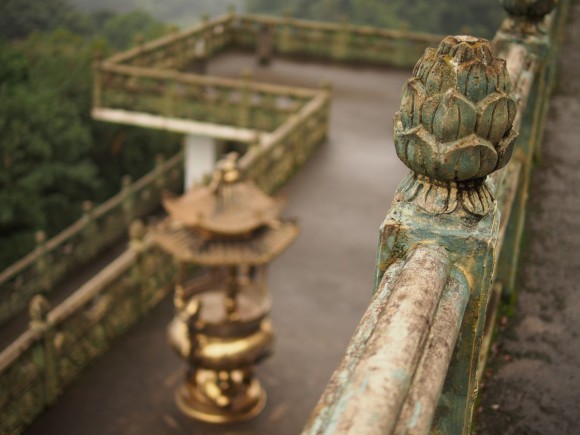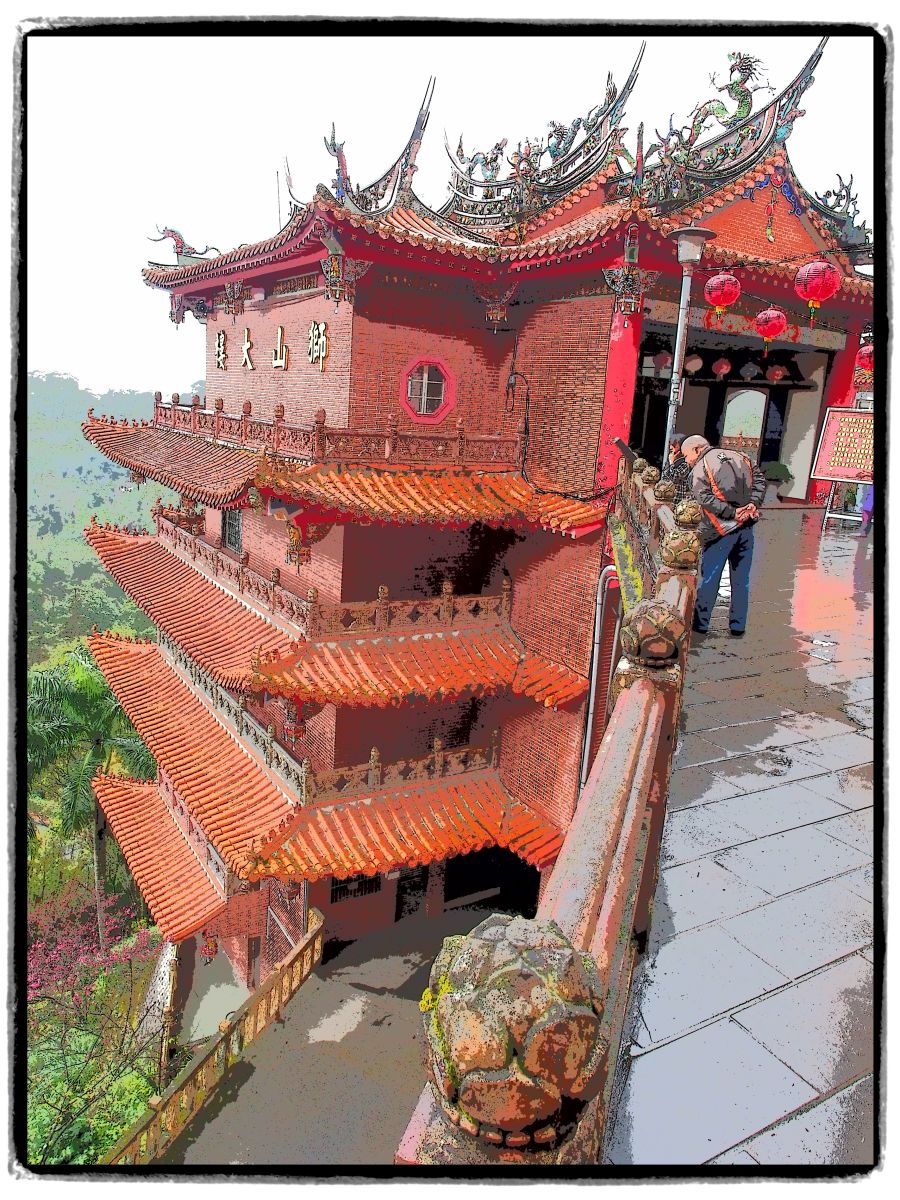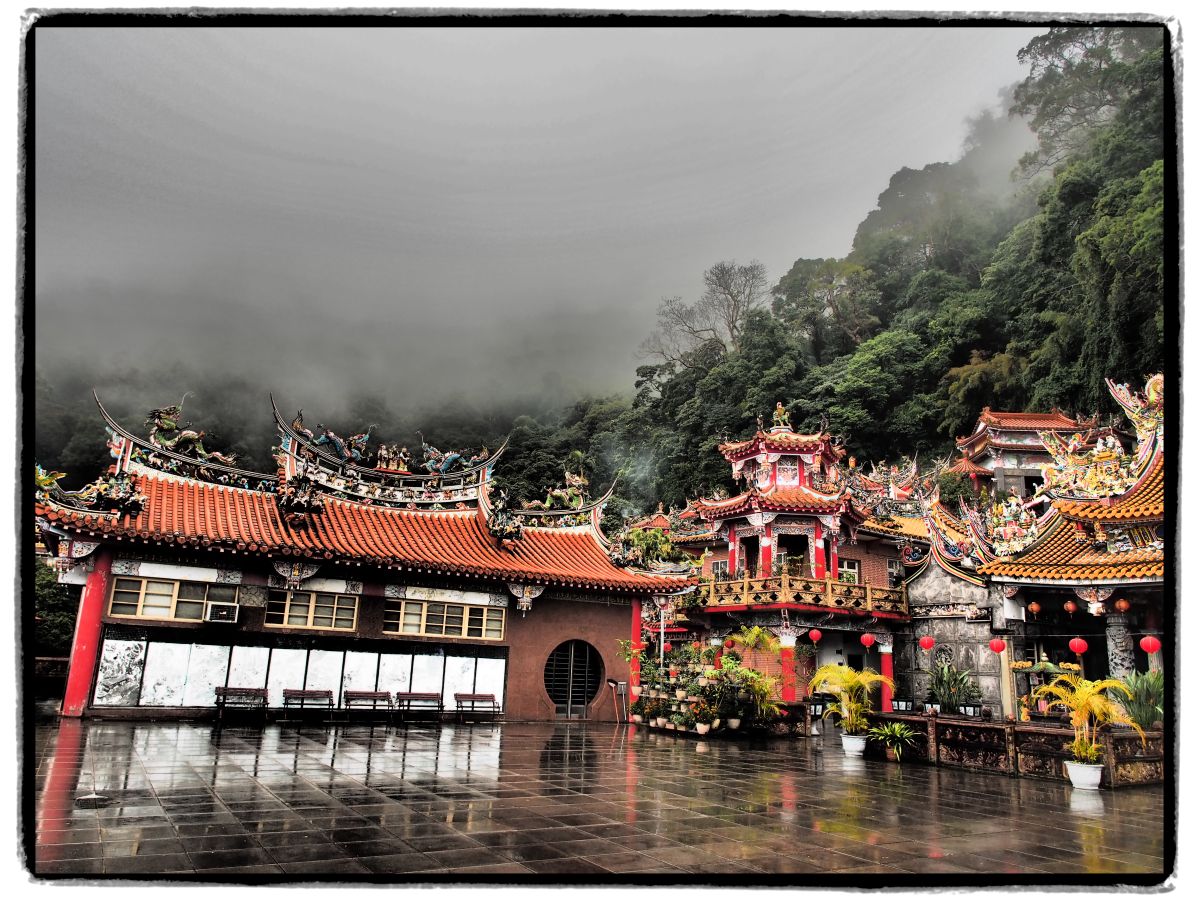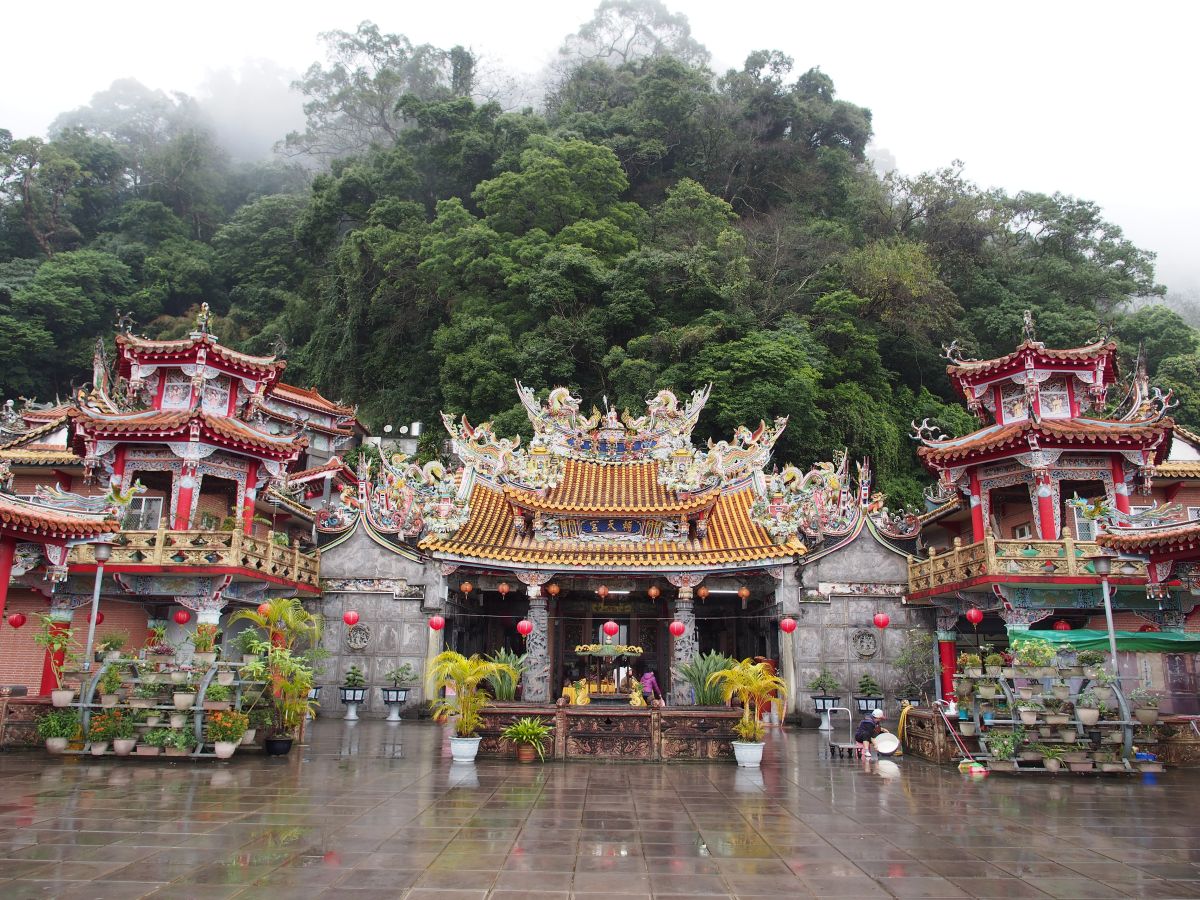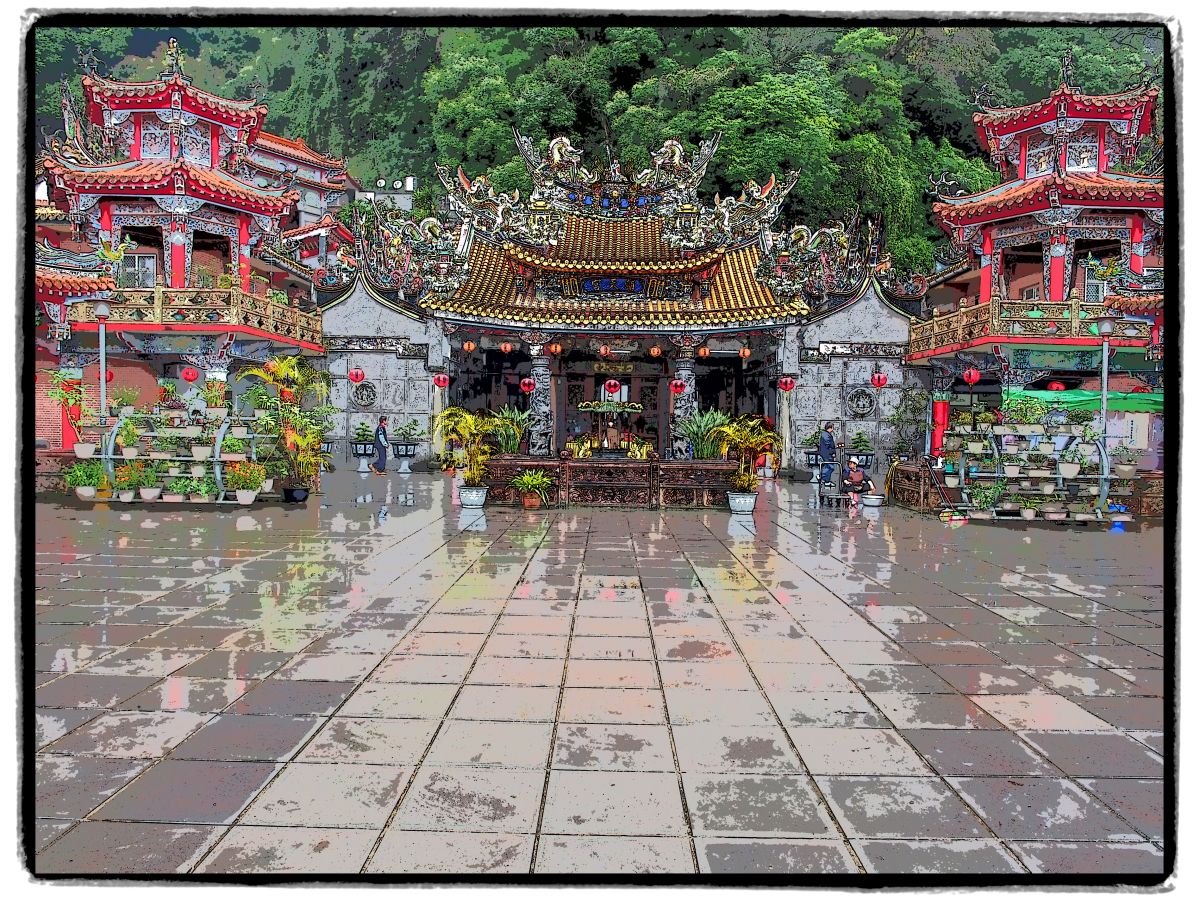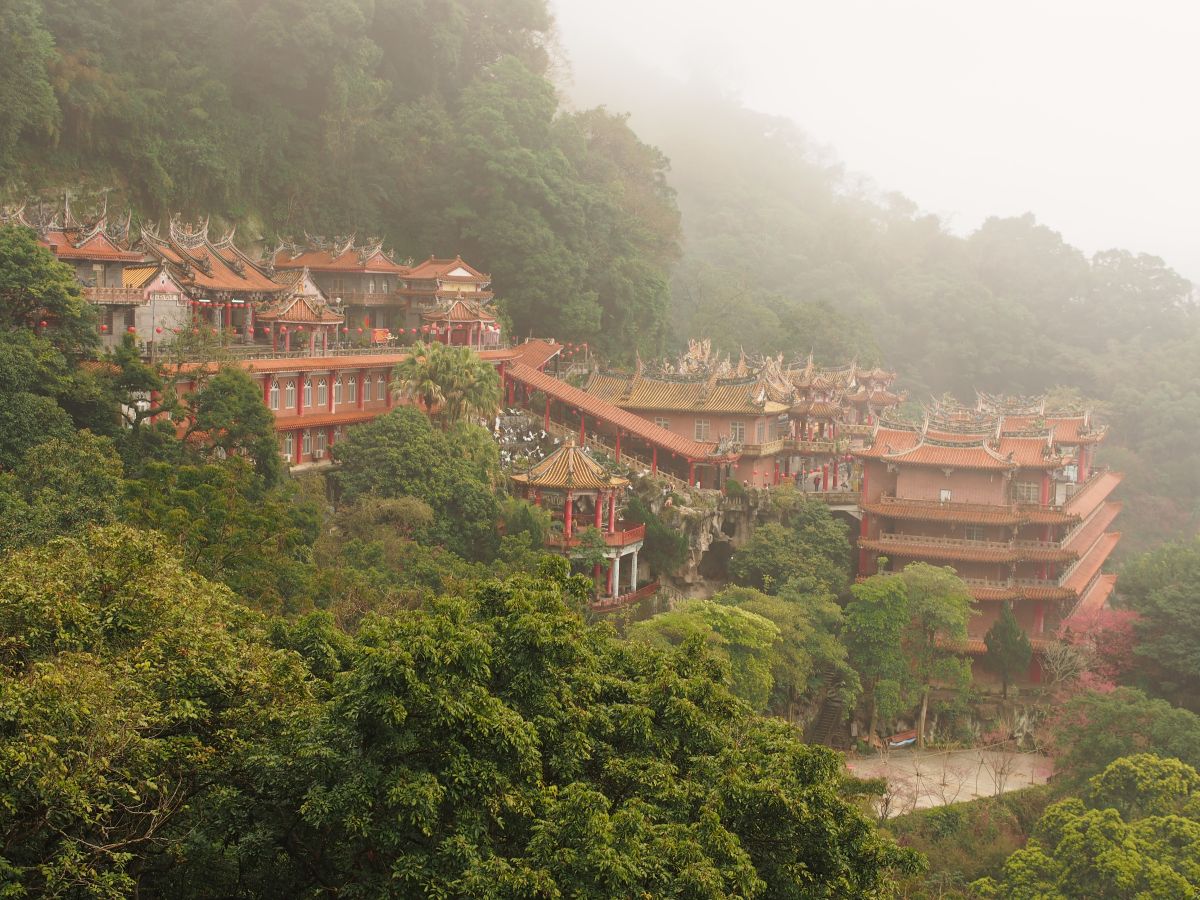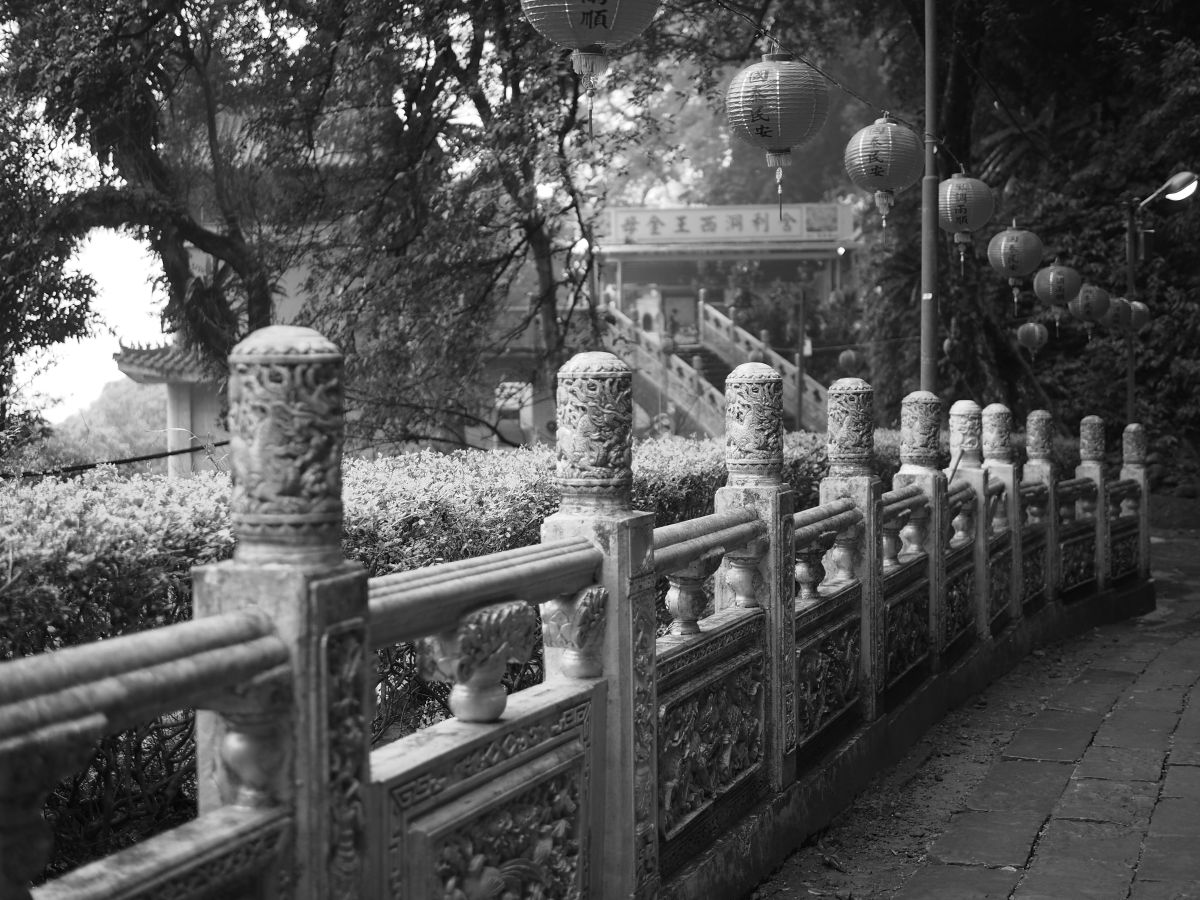Day 3 CNY Scooter Trip 2013
Day 3
Tuesday February 12, 2013
7:00 a.m. Cyuanhua Temple Group
The highlight of my second day on the road was, surprisingly enough, a meal. But I’ll get to that in a minute. I left for my little hike at about 9:30. The sun had not broken through as I hoped it would, but the rain had stopped and the mist and fog had thinned out considerably. Almost none of the day visitors had arrived yet, and I had all the temples to myself as I walked through them with my camera in hand. I put my 24mm wide angle lens on for the occasion to get a couple of full shots of the temples. The first day, I had taken a lot of detail shots and closeups.
There wasn’t a lot of activity that I could see other than a group of women preparing a very large meal out on the cement. There is a big dining room across the path from my place and they serve several meals there a couple of times a day. The fact that meals like that are available, that rooms like mine are available, and dozens of other similar things make up a set of knowledge that most Taiwanese just grow up with. They simply know these things having absorbed them from their parents and daily life. That’s why travel here can be such an adventure at times. All the services that one might want as a traveler are available but often not signposted or indicated in any way. The main population just knows these things already. They don’t need to be told. So when a random visitor like me shows up, there can be some confusion. I say that, but I realize the opposite is also often the case. Many Taiwanese that I know don’t seem to know anything about how things work in their own country. I often appear almost as an expert compared to them. So I guess I don’t know what I’m talking about. I guess some people know some things and others don’t – just like anywhere.
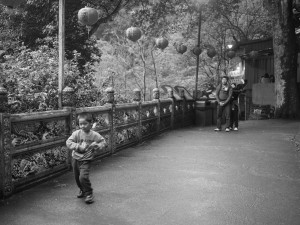 Here and there, people were setting things up and getting ready for the visitors. There appears to be some kind of a fundraising drive on. I assume they are trying to pay for some upkeep and repairs on one or all of the temples. Perhaps this happens every year at Chinese New Year. In any event, one thing you can do is sponsor a roof tile. There are different types of roof tiles ranging from simple to fancy and I assume how much you pay depends on the type of tile you sponsor. When you sponsor one, your name and a message of some kind are written on them. There is also some kind of a big raffle going on. From what I can make out, one of the prizes is a 125cc scooter. This scooter is sitting in the lobby near me as I sit and write enjoying a cup of coffee. People also give donations large and small to the temples. They buy the incense and the paper money that they burn. They can also sponsor these small lights that burn in large towers. Each glowing light represents a sponsor and a donation. The temples also make a lot of money by interpreting people’s fortunes. The economies of these temples are actually quite complex. It would be interesting to hang out in one for a while and see how it all works. I like the temples here very much. They are more like vibrant villages than anything else – open and active and social. I’m still somewhat hesitant to push myself forward and take a close look at things. I try to be respectful and keep my distance, but there is probably no need. Everyone loves to see me here and I could go anywhere I wished without offending or bothering anyone. As I said, it’s quite a social and active scene. Children are running around and playing, people are taking pictures, others are lighting incense and burning ghost money. There is a lot going on.
Here and there, people were setting things up and getting ready for the visitors. There appears to be some kind of a fundraising drive on. I assume they are trying to pay for some upkeep and repairs on one or all of the temples. Perhaps this happens every year at Chinese New Year. In any event, one thing you can do is sponsor a roof tile. There are different types of roof tiles ranging from simple to fancy and I assume how much you pay depends on the type of tile you sponsor. When you sponsor one, your name and a message of some kind are written on them. There is also some kind of a big raffle going on. From what I can make out, one of the prizes is a 125cc scooter. This scooter is sitting in the lobby near me as I sit and write enjoying a cup of coffee. People also give donations large and small to the temples. They buy the incense and the paper money that they burn. They can also sponsor these small lights that burn in large towers. Each glowing light represents a sponsor and a donation. The temples also make a lot of money by interpreting people’s fortunes. The economies of these temples are actually quite complex. It would be interesting to hang out in one for a while and see how it all works. I like the temples here very much. They are more like vibrant villages than anything else – open and active and social. I’m still somewhat hesitant to push myself forward and take a close look at things. I try to be respectful and keep my distance, but there is probably no need. Everyone loves to see me here and I could go anywhere I wished without offending or bothering anyone. As I said, it’s quite a social and active scene. Children are running around and playing, people are taking pictures, others are lighting incense and burning ghost money. There is a lot going on.
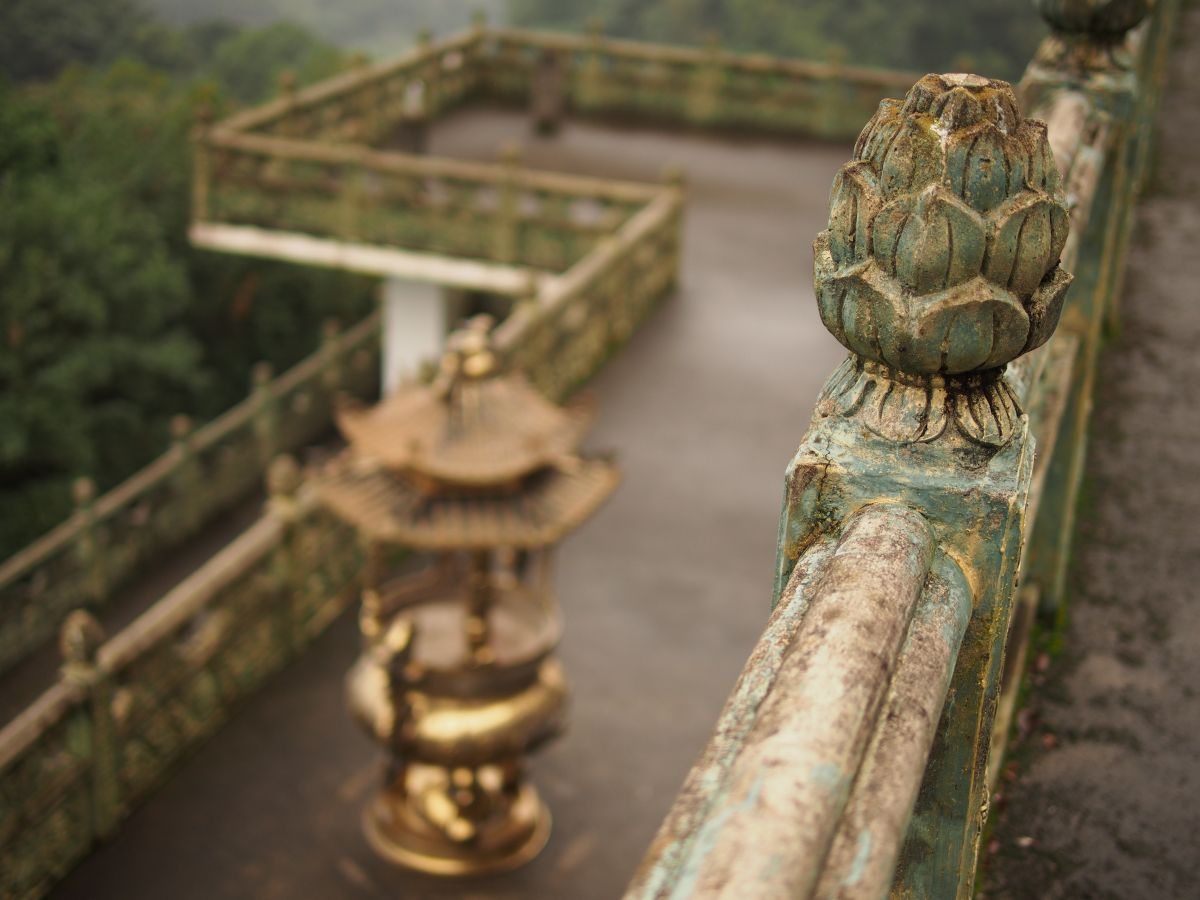 There is also a little shop right up here amongst the temples on the mountainside, and I stopped there to buy a bottle of water for my hike. I have found that there are certain remoter parts of the country that the modern convenience stores haven’t reached, and those niches are still occupied by little shops like this. I find it interesting that these shops contain a completely different range of products. They do carry the same types of goods, everything from chocolate bars to laundry soap. However, the brands are often different. The candy display contains no Snickers Bars, no M&Ms, or any other modern brand. Instead there are local equivalents – usually of a very inferior nature, I must add. You can also never be sure how long these items have been sitting on the shelves. I’ve occasionally purchased crackers and such things and had reason to believe that they dated from the Shang Dynasty – dry and stale and way past the end of their shelf life.
There is also a little shop right up here amongst the temples on the mountainside, and I stopped there to buy a bottle of water for my hike. I have found that there are certain remoter parts of the country that the modern convenience stores haven’t reached, and those niches are still occupied by little shops like this. I find it interesting that these shops contain a completely different range of products. They do carry the same types of goods, everything from chocolate bars to laundry soap. However, the brands are often different. The candy display contains no Snickers Bars, no M&Ms, or any other modern brand. Instead there are local equivalents – usually of a very inferior nature, I must add. You can also never be sure how long these items have been sitting on the shelves. I’ve occasionally purchased crackers and such things and had reason to believe that they dated from the Shang Dynasty – dry and stale and way past the end of their shelf life.
Further up the trail leading through the group of temples, there is a long and narrow stall selling all manner of products from elaborate wooden walking sticks to wooden flutes. The man who runs this shop plays a flute to attract customers and pass the time. He plays all day every day nonstop and it adds a nice atmosphere to the area around him. A short distance on past a temple or two, there are a couple of food stalls. They sell some home-cooked local food as well as drinks and some souvenir items. I have no idea how they work. I wonder if they work for themselves. If so, how did they get the right to have a shop there? Or perhaps they are part of the economy of the temple group. In any event, the food they served didn’t look appealing to me and I passed them by. I had my eyes on another meal – the one I mentioned at the beginning.
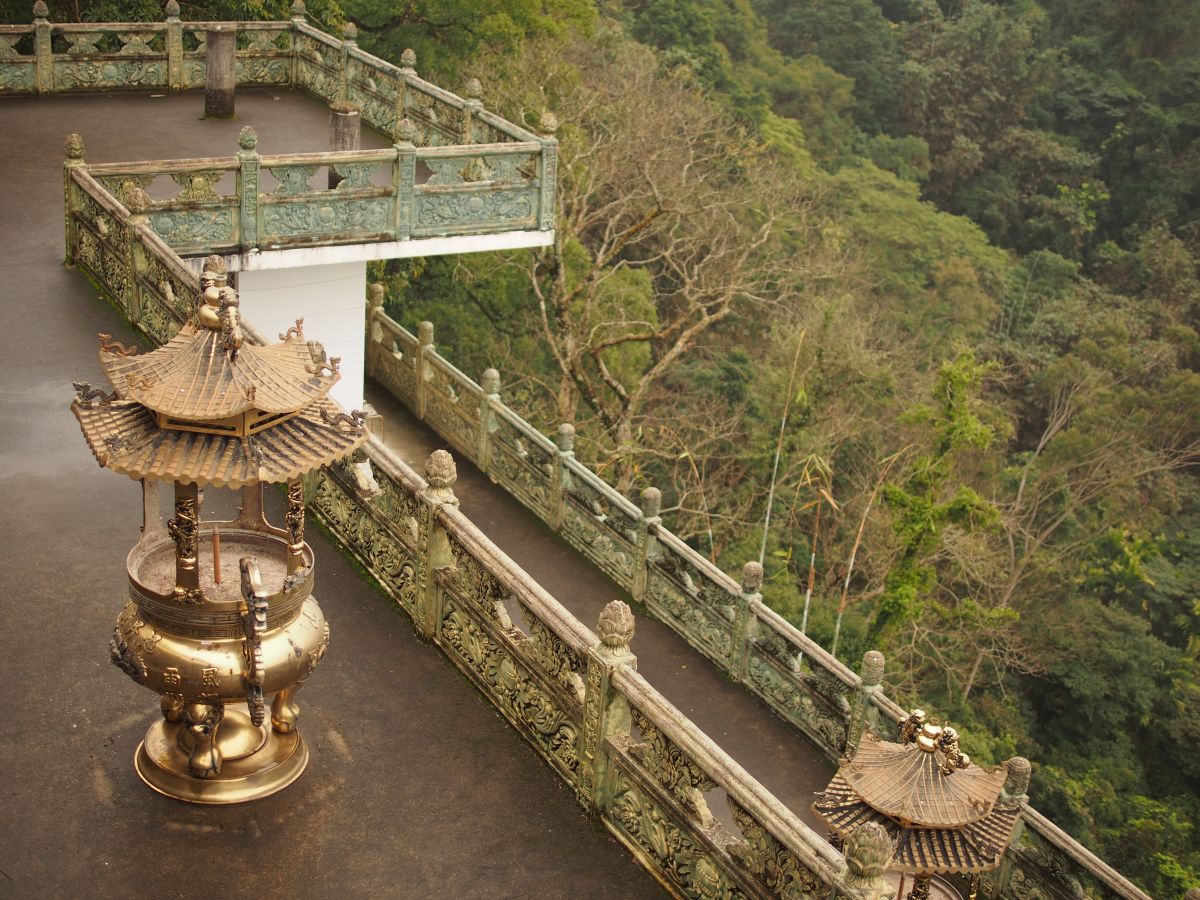 The first part of my hike consisted of a long climb up some stone steps. I encountered a man up there sweeping leaves off the steps and he wished me a happy new year. I’ve spoken to men like him in the past at other temples, and I’ve invariably found that they were volunteers. Many people volunteer their time on the weekends and during holidays to do work at the various temples. It might seem strange to worry about sweeping leaves in a thick forest, but it’s understandable. The most dangerous aspect of these hikes is how slippery the stone surfaces can become. It’s a very wet country, and leaves on the stones are extremely slippery – like ice. Mold and fungus of various types also grow on these stone steps and that results in an even more slippery surface. It’s particularly dangerous going down. It takes only a momentary lack of concentration for your foot to go flying out from under you resulting in a painful crash on those hard stones. It would likely be safer and more pleasant to simply leave the trails as normal trails instead of “improving” them with stone steps, but the local people think differently. I think this tendency to put in steps everywhere comes partially from how much erosion there is. The rains that come with typhoons are so heavy that hillsides and mountainsides get washed away routinely. Trails would require constant care and repair. Perhaps these stone steps are more durable.
The first part of my hike consisted of a long climb up some stone steps. I encountered a man up there sweeping leaves off the steps and he wished me a happy new year. I’ve spoken to men like him in the past at other temples, and I’ve invariably found that they were volunteers. Many people volunteer their time on the weekends and during holidays to do work at the various temples. It might seem strange to worry about sweeping leaves in a thick forest, but it’s understandable. The most dangerous aspect of these hikes is how slippery the stone surfaces can become. It’s a very wet country, and leaves on the stones are extremely slippery – like ice. Mold and fungus of various types also grow on these stone steps and that results in an even more slippery surface. It’s particularly dangerous going down. It takes only a momentary lack of concentration for your foot to go flying out from under you resulting in a painful crash on those hard stones. It would likely be safer and more pleasant to simply leave the trails as normal trails instead of “improving” them with stone steps, but the local people think differently. I think this tendency to put in steps everywhere comes partially from how much erosion there is. The rains that come with typhoons are so heavy that hillsides and mountainsides get washed away routinely. Trails would require constant care and repair. Perhaps these stone steps are more durable.
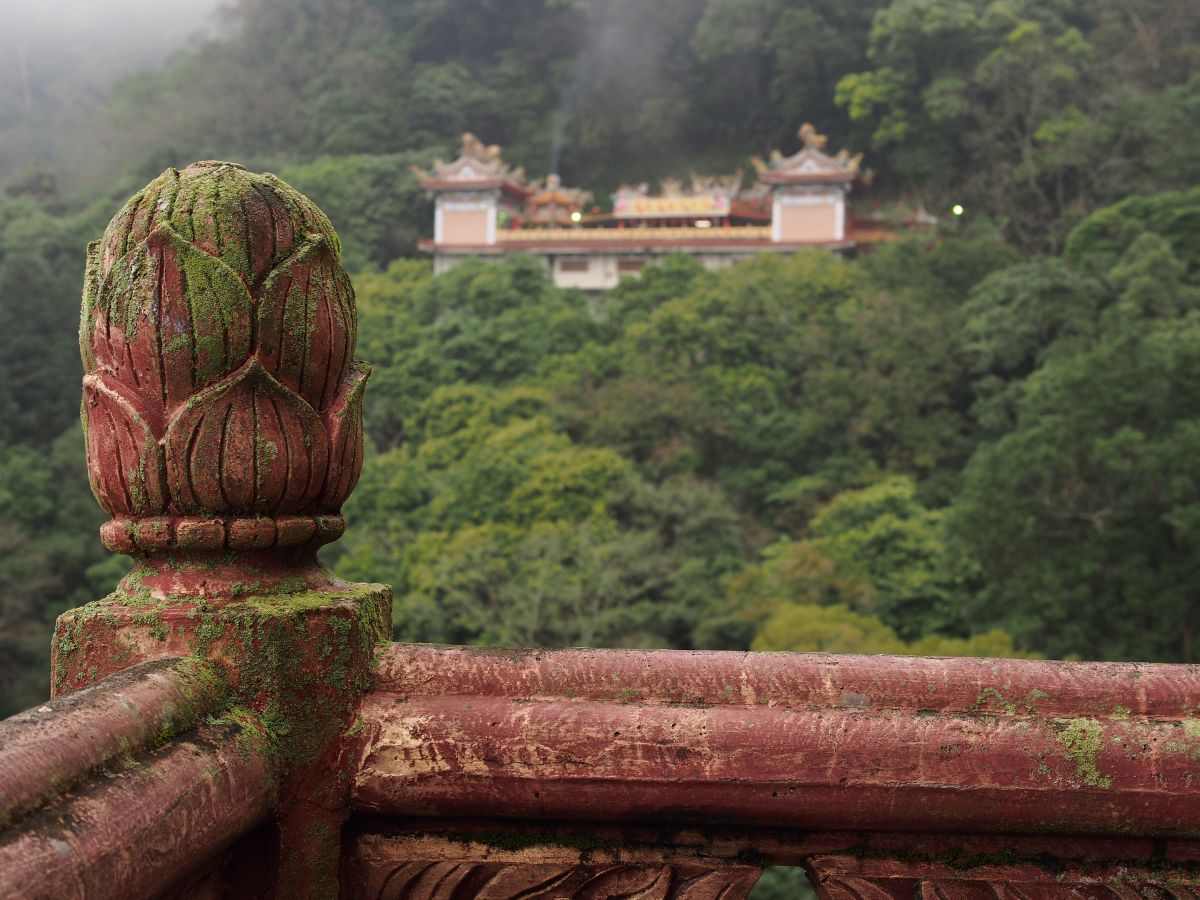 Unfortunately, on this particular hike, even the stone steps didn’t last. When I got to the highest point of my hike, the steps disappeared and were replaced with actual pavement. And what is called the historic Shian Trail is really nothing more than a narrow paved road. That was a big disappointment. On the information boards, I read that this part of the trail had been “improved” and I guess that meant destroying the trail and replacing it with a road. I don’t think of that as an improvement. There is a certain monotony to hiking along a road that can easily take the pleasure out of hiking. The gradient is usually exactly the same and quite steep and your legs and feet tire from the constant and regular pacing downwards. And as you walk along a road, you can’t help but have your motivation drained out of you. You start to wonder what the point of hiking is when you could just drive. Plus, in order to accommodate the few vehicles that would take this road, they have to put in long switchbacks as the road slowly goes back and forth and back and forth with a tight turn at each end to slowly climb up the mountain. I’m sure the original trail did not follow that pattern but instead went straight up and down along a more interesting route. By adding the switchbacks, the trail will triple or quadruple in length. I don’t know when this historic trail was turned into a road. It could have been done a long time ago, but the maps still showed it as an actual trail. The first part from my temple group to the top of the mountain was quite pleasant and interesting. After that, it was basically like hiking along any road in Taiwan. I thought that there would be a trail branching off from the road, but if there was such a thing, I never found it. I don’t think there was, since there were lots of hikers on the road with me. They were decked out for the most part in full hiking gear – boots, hiking sticks, leggings, etc – but walking along a road just like me.
Unfortunately, on this particular hike, even the stone steps didn’t last. When I got to the highest point of my hike, the steps disappeared and were replaced with actual pavement. And what is called the historic Shian Trail is really nothing more than a narrow paved road. That was a big disappointment. On the information boards, I read that this part of the trail had been “improved” and I guess that meant destroying the trail and replacing it with a road. I don’t think of that as an improvement. There is a certain monotony to hiking along a road that can easily take the pleasure out of hiking. The gradient is usually exactly the same and quite steep and your legs and feet tire from the constant and regular pacing downwards. And as you walk along a road, you can’t help but have your motivation drained out of you. You start to wonder what the point of hiking is when you could just drive. Plus, in order to accommodate the few vehicles that would take this road, they have to put in long switchbacks as the road slowly goes back and forth and back and forth with a tight turn at each end to slowly climb up the mountain. I’m sure the original trail did not follow that pattern but instead went straight up and down along a more interesting route. By adding the switchbacks, the trail will triple or quadruple in length. I don’t know when this historic trail was turned into a road. It could have been done a long time ago, but the maps still showed it as an actual trail. The first part from my temple group to the top of the mountain was quite pleasant and interesting. After that, it was basically like hiking along any road in Taiwan. I thought that there would be a trail branching off from the road, but if there was such a thing, I never found it. I don’t think there was, since there were lots of hikers on the road with me. They were decked out for the most part in full hiking gear – boots, hiking sticks, leggings, etc – but walking along a road just like me.
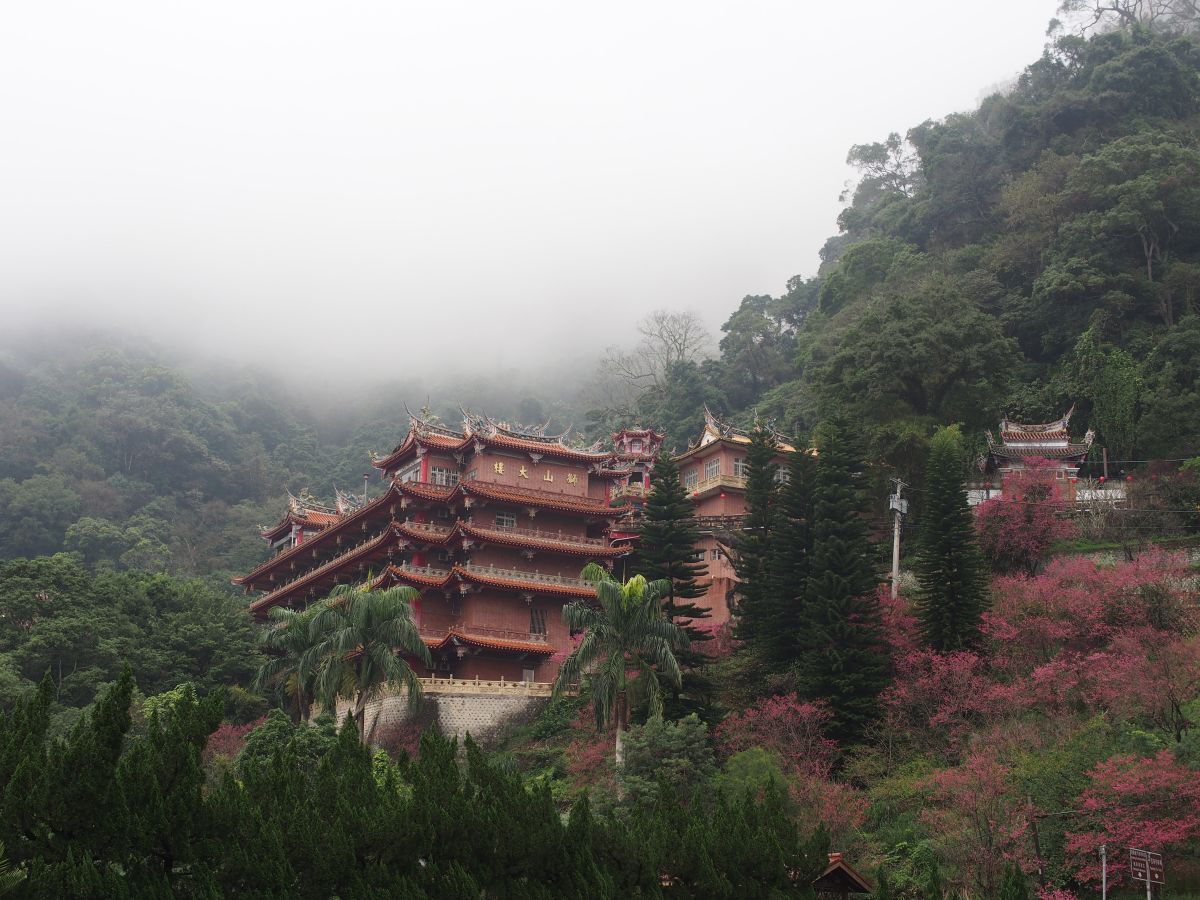 The temples on the other side of the mountain were also something of a disappointment. I had expected to find temples similar to the ones in the Cyuanhua Group, but they were all quite plain and uninteresting and with unimpressive settings. I’m trying to think of something positive to say about that part of the hike, but I can’t really think of anything. It was still enjoyable for me since I was at least passing new sights and there were lots of people on the road, and they all greeted me in one way or another. There were also signboards here and there with information in both Chinese and English about the wildlife to be found in the area – everything from the Rhinocerous beetle to the Luna Month.
The temples on the other side of the mountain were also something of a disappointment. I had expected to find temples similar to the ones in the Cyuanhua Group, but they were all quite plain and uninteresting and with unimpressive settings. I’m trying to think of something positive to say about that part of the hike, but I can’t really think of anything. It was still enjoyable for me since I was at least passing new sights and there were lots of people on the road, and they all greeted me in one way or another. There were also signboards here and there with information in both Chinese and English about the wildlife to be found in the area – everything from the Rhinocerous beetle to the Luna Month.
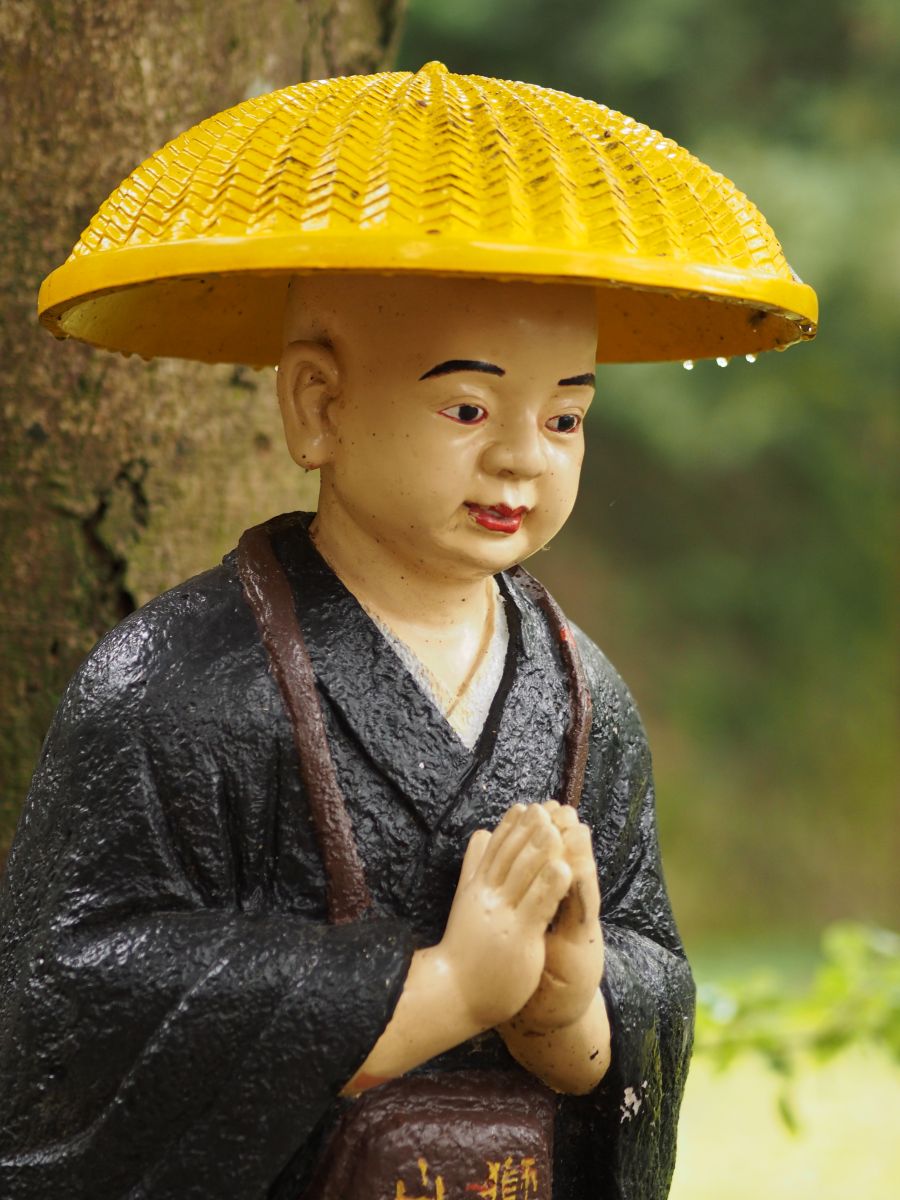 A curious and telling aspect to these many information signs and tourist maps is that they are often covered in green mold. The mold can be so thick as to completely obscure the pictures and text beneath. At one sign, I took out some Kleenex to see how easy or difficult it was to remove the mold. To my surprise, the mold came away quite easily with just a moderate amount of elbow grease and a regular Kleenex. Someone with more time to spare and any kind of special scrubber or solvent could probably keep those signs and maps clear and legible very easily. That they don’t do that is somewhat typical of Taiwan. I find that money and effort will be poured into building something. But then there is rarely a budget for any type of maintenance. Things are built and then left to rot. This fact is compounded by a tendency to purchase the cheapest things possible. This is all part of a general false economy that leads to Taiwan often seeming more like a third world country than a developed one with a modern and rich economy. The hotels I’ve stayed in are a good example of this. Almost without exception, the bathroom fittings and other furniture in any hotel are of the cheapest quality you can imagine and it all starts to fall apart from the day the hotel opens and then never gets repaired or replaced. I’ve wondered sometimes – with a smile – if this tendency comes from the extreme age of Chinese culture and civilization. Perhaps people are simply accustomed to things being old, so even when they build something new, they don’t mind if it looks old and falls apart within a month or two. All that seems to matter is that the original purchase price or the cost of construction is as low as possible. You see this in personal expenses as well as public ones. People will buy the cheapest shoes possible in the market and not mind at all that these cheap shoes will fall apart very quickly. What’s important is that they look good and cost little. And I guess when you never see the alternative, this just feels natural and normal. For foreigners coming to live in Taiwan, it is different. We’ve seen the alternative. I came to Taiwan a long time ago with two pairs of shoes that I bought in Canada at a good store. Those shoes lasted a solid eight or nine years. All the shoes that I’ve purchased in Taiwan barely make it past one year. Things just fall apart here.
A curious and telling aspect to these many information signs and tourist maps is that they are often covered in green mold. The mold can be so thick as to completely obscure the pictures and text beneath. At one sign, I took out some Kleenex to see how easy or difficult it was to remove the mold. To my surprise, the mold came away quite easily with just a moderate amount of elbow grease and a regular Kleenex. Someone with more time to spare and any kind of special scrubber or solvent could probably keep those signs and maps clear and legible very easily. That they don’t do that is somewhat typical of Taiwan. I find that money and effort will be poured into building something. But then there is rarely a budget for any type of maintenance. Things are built and then left to rot. This fact is compounded by a tendency to purchase the cheapest things possible. This is all part of a general false economy that leads to Taiwan often seeming more like a third world country than a developed one with a modern and rich economy. The hotels I’ve stayed in are a good example of this. Almost without exception, the bathroom fittings and other furniture in any hotel are of the cheapest quality you can imagine and it all starts to fall apart from the day the hotel opens and then never gets repaired or replaced. I’ve wondered sometimes – with a smile – if this tendency comes from the extreme age of Chinese culture and civilization. Perhaps people are simply accustomed to things being old, so even when they build something new, they don’t mind if it looks old and falls apart within a month or two. All that seems to matter is that the original purchase price or the cost of construction is as low as possible. You see this in personal expenses as well as public ones. People will buy the cheapest shoes possible in the market and not mind at all that these cheap shoes will fall apart very quickly. What’s important is that they look good and cost little. And I guess when you never see the alternative, this just feels natural and normal. For foreigners coming to live in Taiwan, it is different. We’ve seen the alternative. I came to Taiwan a long time ago with two pairs of shoes that I bought in Canada at a good store. Those shoes lasted a solid eight or nine years. All the shoes that I’ve purchased in Taiwan barely make it past one year. Things just fall apart here.
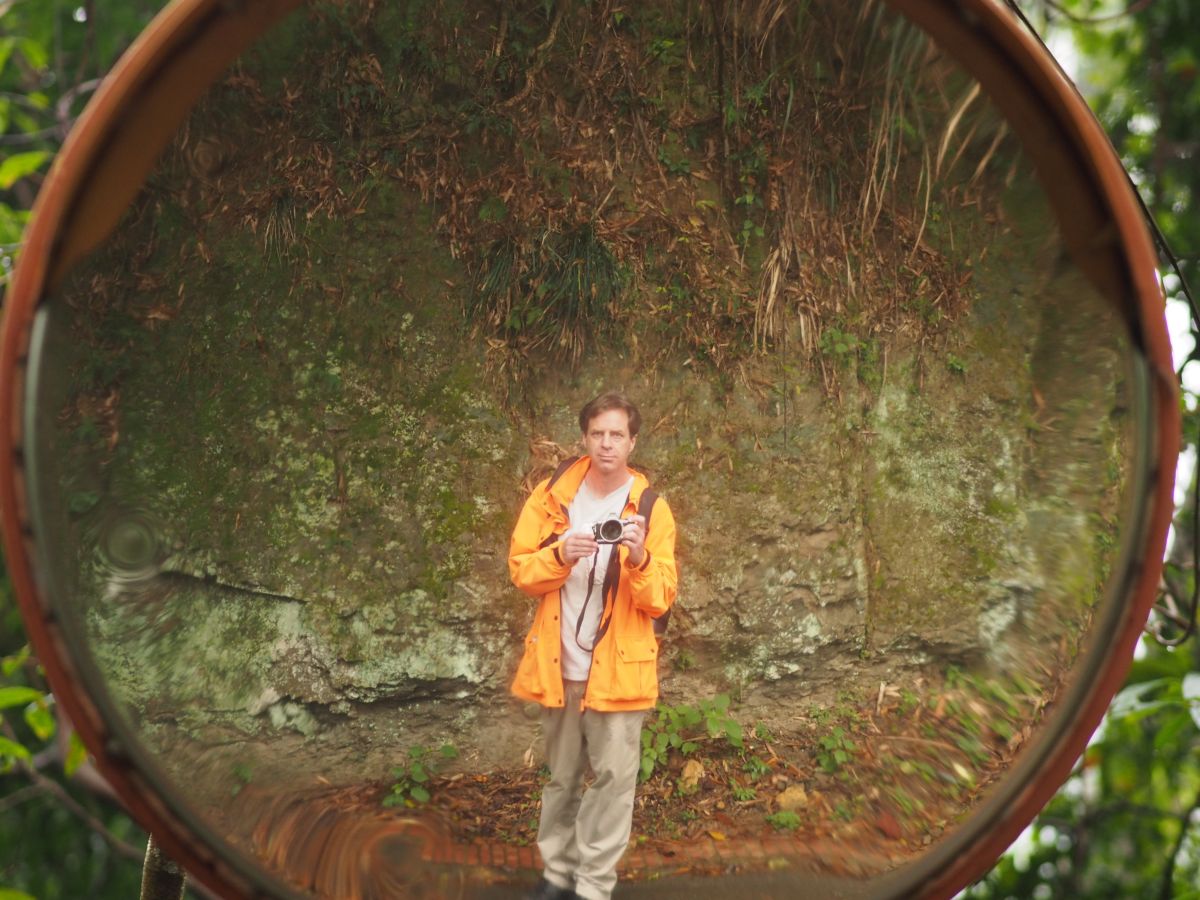 Quite often this pattern leads to amusing consequences. While out hiking on my first day here, I came across a beautiful series of statues. These statues were about life-size and there were a couple of hundred of them arranged in rows going down a series of trails that switched back and forth down the mountain side. The whole site looked extremely old. The statues were falling apart and weathered. Hands had fallen off. Torsos had cracked. The trails themselves had collapsed. I only made it down two trails before I reached an impassable point. Landslides had carried away the rest. All in all, it seemed an ancient site – hundreds of years old – weathered and mysterious. Then I reached out and touched one of the statues – it was hollow plastic! I thought they were stone statues dating from an ancient time. In fact, they were just a plastic display probably put in place ten years ago and then abandoned and not maintained. The plastic soon became brittle in the extreme weather and fell apart. Mold and mildew and spiderwebs covered them all. The trails – which had had no engineering put into them at all – simply disintegrated at the first heavy rain. I’m sure it looked very impressive on the first day and maybe even in the first month. By the second month, the whole thing probably looked like it did now – a ruin. And, again, maybe that is the point. The Chinese would be used to ancient ruins. So modern things are built to fall apart and look like ancient ruins as quickly as possible.
Quite often this pattern leads to amusing consequences. While out hiking on my first day here, I came across a beautiful series of statues. These statues were about life-size and there were a couple of hundred of them arranged in rows going down a series of trails that switched back and forth down the mountain side. The whole site looked extremely old. The statues were falling apart and weathered. Hands had fallen off. Torsos had cracked. The trails themselves had collapsed. I only made it down two trails before I reached an impassable point. Landslides had carried away the rest. All in all, it seemed an ancient site – hundreds of years old – weathered and mysterious. Then I reached out and touched one of the statues – it was hollow plastic! I thought they were stone statues dating from an ancient time. In fact, they were just a plastic display probably put in place ten years ago and then abandoned and not maintained. The plastic soon became brittle in the extreme weather and fell apart. Mold and mildew and spiderwebs covered them all. The trails – which had had no engineering put into them at all – simply disintegrated at the first heavy rain. I’m sure it looked very impressive on the first day and maybe even in the first month. By the second month, the whole thing probably looked like it did now – a ruin. And, again, maybe that is the point. The Chinese would be used to ancient ruins. So modern things are built to fall apart and look like ancient ruins as quickly as possible.
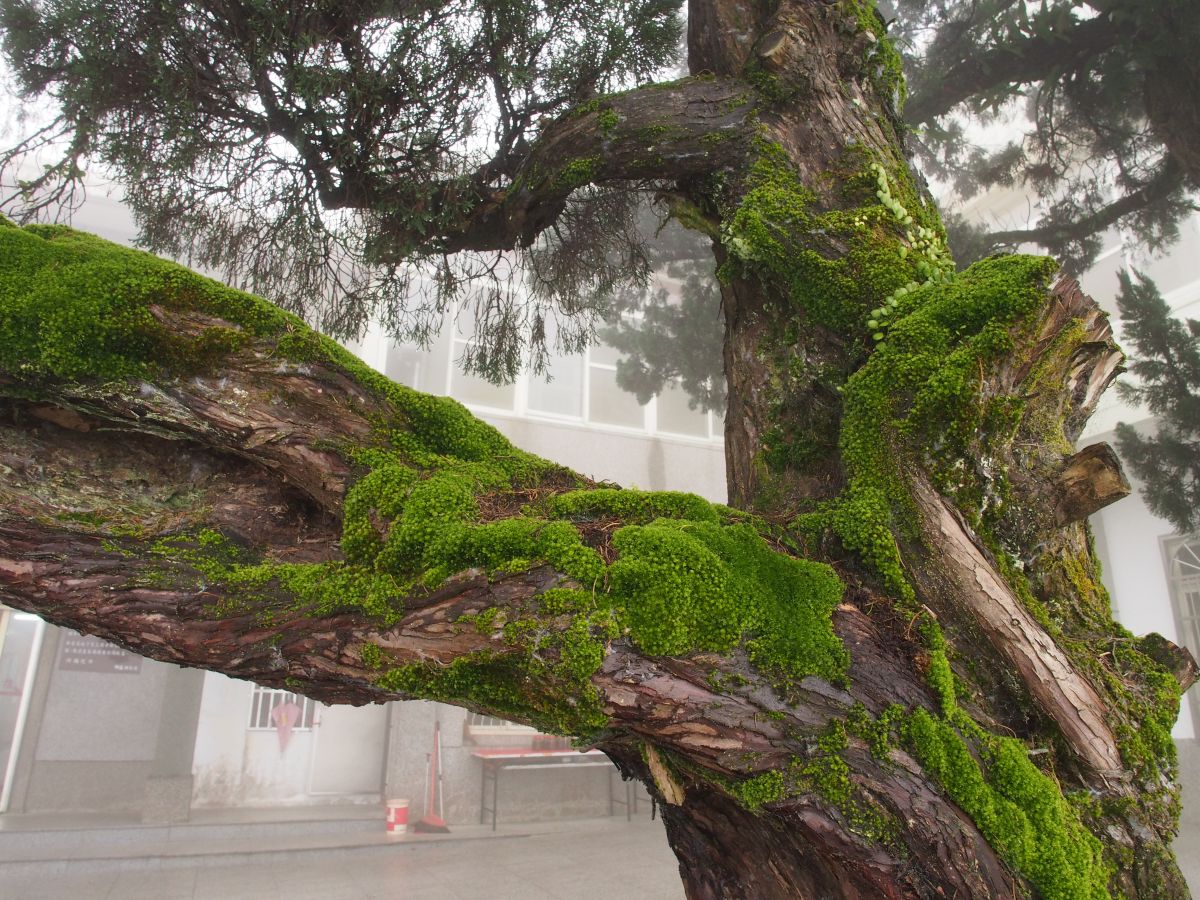 The road I was hiking along ended at the Visitor Center on the other side of Lion’s Head Mountain – the place that I had stopped at on my first day. On that day (and on a previous visit years ago), I’d noticed a beautiful restaurant complete with fish ponds and wooden balconies. I hadn’t had breakfast before my hike and the idea was to save my appetite for a good lunch at this restaurant. They had set meals for NT$180, which is about $6.
The road I was hiking along ended at the Visitor Center on the other side of Lion’s Head Mountain – the place that I had stopped at on my first day. On that day (and on a previous visit years ago), I’d noticed a beautiful restaurant complete with fish ponds and wooden balconies. I hadn’t had breakfast before my hike and the idea was to save my appetite for a good lunch at this restaurant. They had set meals for NT$180, which is about $6.
The owners of the restaurant were Hakka and they served Hakka food. The man who owned the restaurant brought out an iPad and he swiped through a series of pictures of the various set meals. I quickly settled on Set 1 as my lunch and found a table inside and upstairs. It was a bit cold and windy to be sitting outside. The meal, as I said earlier, was the highlight of the hike. Perhaps it was the hike that had sharpened my appetite. In any event, it was delicious and well worth the long walk to get there – rice, pork, soup, and vegetables of many varieties. It was all hot and all tasty. I could eat a meal like that every day.
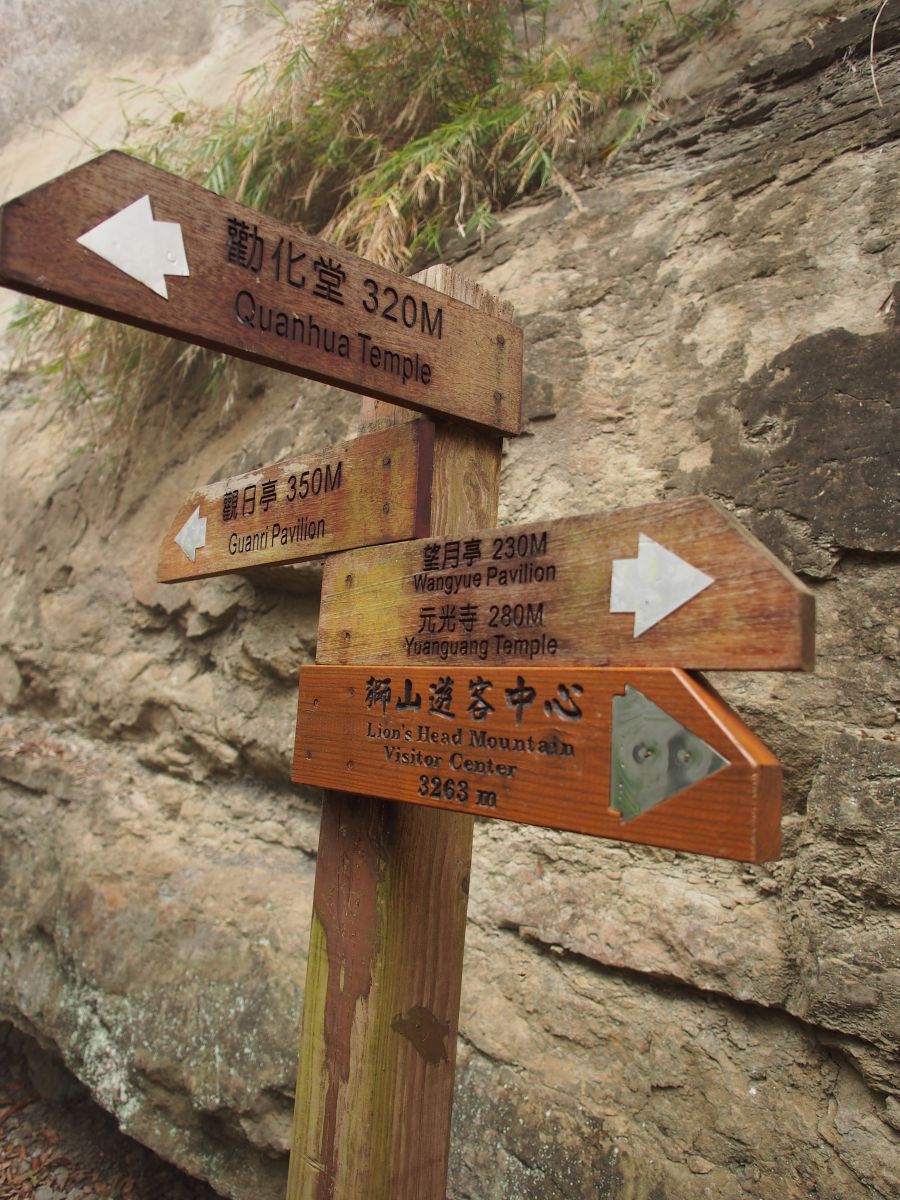 My original plan had been to hike back over the mountain to my starting point and my home for the night. However, when I spotted a convenient shuttle bus, I changed my mind. I didn’t see any particular reason to walk back up that long road. Had it been an actual trail, I would have done it. This shuttle bus ran a route from the Visitor Center to the Cyuanhua Temple group and then on to the old town of Nanjhuang. It wasn’t leaving for half an hour, but I took a seat inside the bus and passed the time reading a book on my Kindle. (I’m currently reading the novel “The Help”.) The bus was full when we left and we raced along the winding road. I was quickly and forcefully reminded of why it’s better to drive your own scooter or ride a bicycle or even hike than to take public transportation. It was horribly cramped and uncomfortable inside the bus. Exhaust from the engine leaking in through cracks in the door combined with the extreme swaying from side to side to make me motion sick within minutes. I couldn’t wait for that trip to end, and it only lasted for fifteen or twenty minutes. Being on buses like that for hours at a time while traveling is a fate worse than death for me. While on the bus even for that short time, I started to wish I’d hiked back. Even two or three hours of walking down a boring road would be more enjoyable than being trapped inside that bus. On the positive side, it was a new experience, and that is always good. Plus, I wasn’t charged anything. The driver waved off my fare with a smile.
My original plan had been to hike back over the mountain to my starting point and my home for the night. However, when I spotted a convenient shuttle bus, I changed my mind. I didn’t see any particular reason to walk back up that long road. Had it been an actual trail, I would have done it. This shuttle bus ran a route from the Visitor Center to the Cyuanhua Temple group and then on to the old town of Nanjhuang. It wasn’t leaving for half an hour, but I took a seat inside the bus and passed the time reading a book on my Kindle. (I’m currently reading the novel “The Help”.) The bus was full when we left and we raced along the winding road. I was quickly and forcefully reminded of why it’s better to drive your own scooter or ride a bicycle or even hike than to take public transportation. It was horribly cramped and uncomfortable inside the bus. Exhaust from the engine leaking in through cracks in the door combined with the extreme swaying from side to side to make me motion sick within minutes. I couldn’t wait for that trip to end, and it only lasted for fifteen or twenty minutes. Being on buses like that for hours at a time while traveling is a fate worse than death for me. While on the bus even for that short time, I started to wish I’d hiked back. Even two or three hours of walking down a boring road would be more enjoyable than being trapped inside that bus. On the positive side, it was a new experience, and that is always good. Plus, I wasn’t charged anything. The driver waved off my fare with a smile.
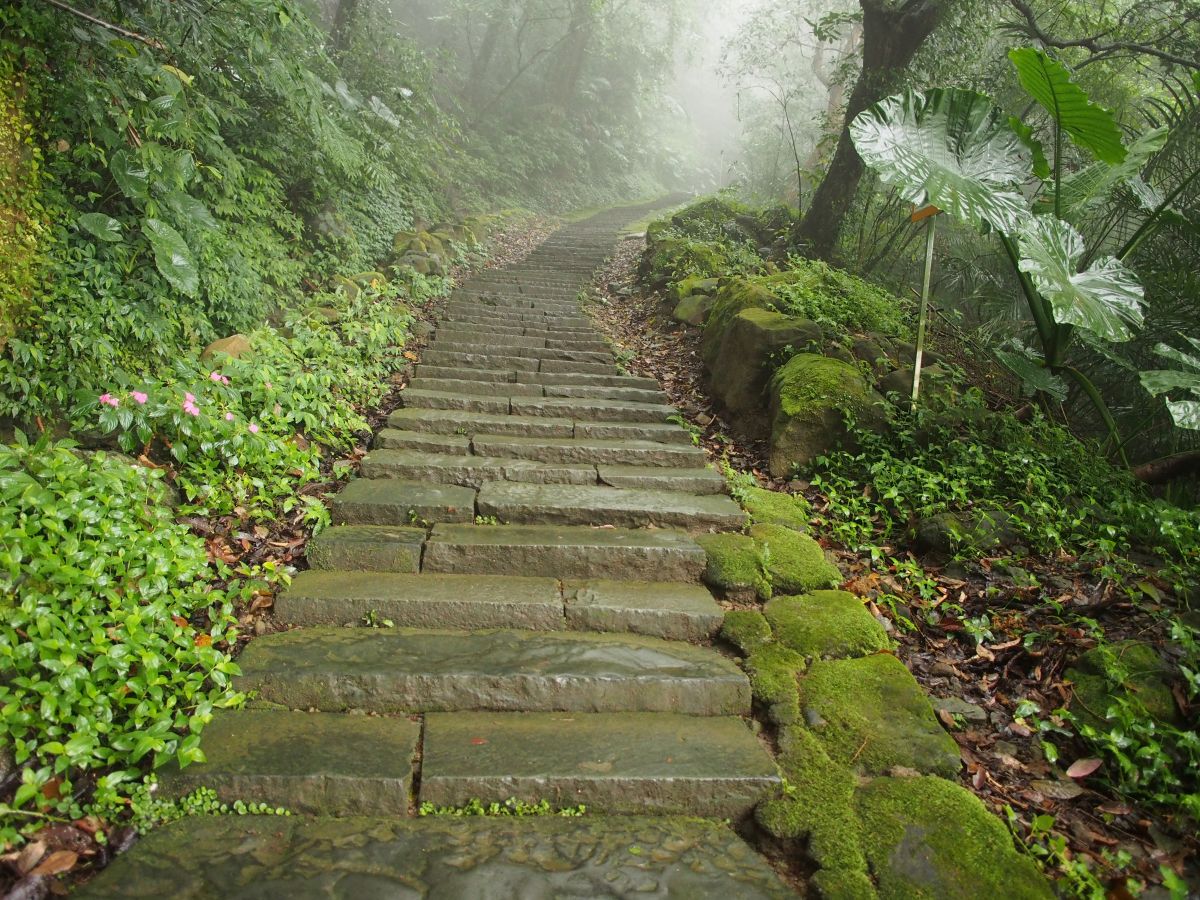 Perhaps by not doing the return hike I missed out on some experiences, but being back at the temple group so early gave me enough time to do some more exploring on this side of the mountain. I had spotted a very tall pagoda on the previous day, and I set off to track it down once I’d had a few minutes to settle back into my room and relax. From the pagoda, I got a beautiful view of the river valley below. It gave me just a hint of how beautiful it would be up here on a sunny and clear day. The mist and the fog have their own beauty, so I don’t mind that much, but it would also be nice to be able to see the distant mountains and get a sense of the setting of this place. Near the pagoda, I saw another building that seemed to serve as some kind of hotel. It looked considerably less comfortable than the place I’m in, but it would likely be cheaper. Again, there were no obvious signs that it was a place for visitors to stay. I think you just have to know about it in advance in order to call and make reservations. I saw several large groups of people moving in and out – usually young people.
Perhaps by not doing the return hike I missed out on some experiences, but being back at the temple group so early gave me enough time to do some more exploring on this side of the mountain. I had spotted a very tall pagoda on the previous day, and I set off to track it down once I’d had a few minutes to settle back into my room and relax. From the pagoda, I got a beautiful view of the river valley below. It gave me just a hint of how beautiful it would be up here on a sunny and clear day. The mist and the fog have their own beauty, so I don’t mind that much, but it would also be nice to be able to see the distant mountains and get a sense of the setting of this place. Near the pagoda, I saw another building that seemed to serve as some kind of hotel. It looked considerably less comfortable than the place I’m in, but it would likely be cheaper. Again, there were no obvious signs that it was a place for visitors to stay. I think you just have to know about it in advance in order to call and make reservations. I saw several large groups of people moving in and out – usually young people.
After that, I still had enough time for one more hike and I chose a looping trail that began at the far end of the temple group. This gave me the opportunity for one last stroll through the temples to look around. I switched my camera over to black and white to take advantage of the shapes around me.
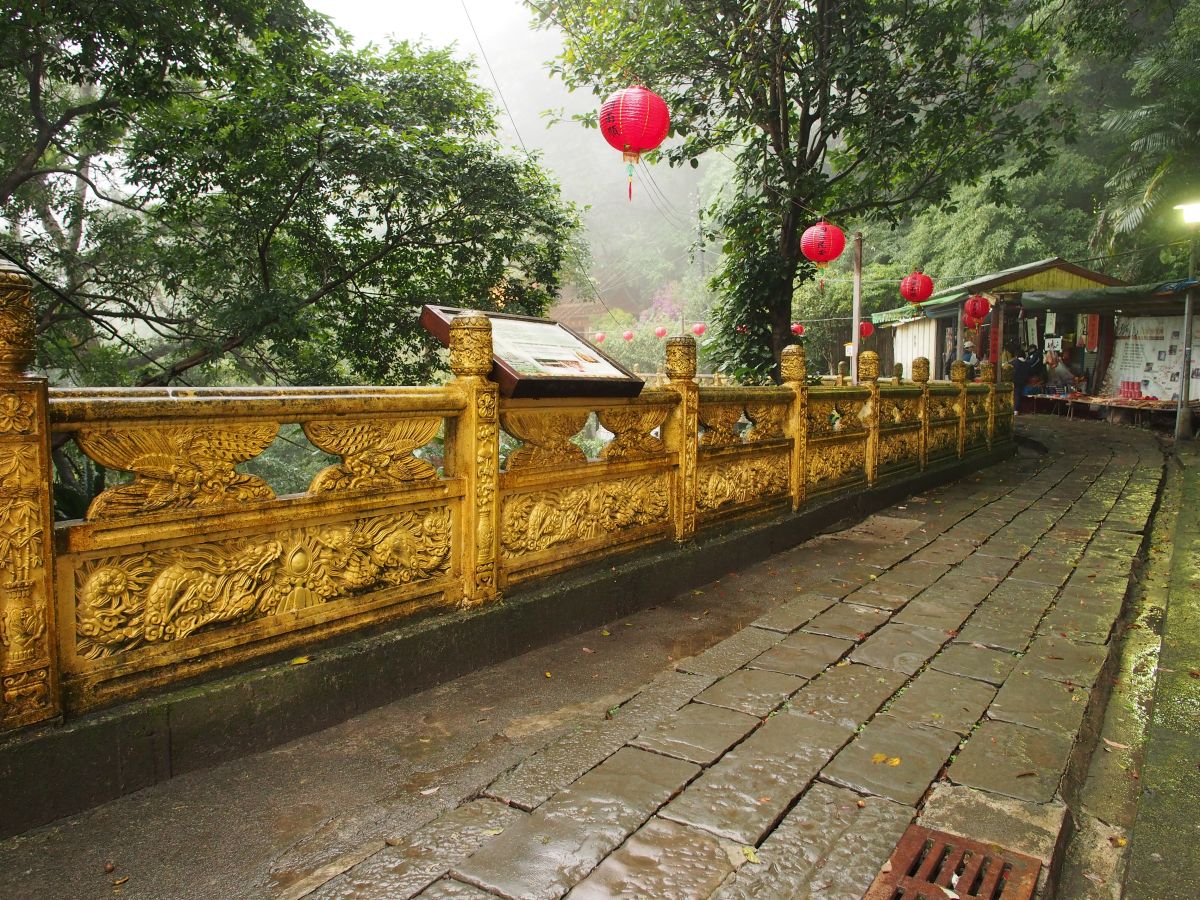 This last trail was a very beautiful and natural one with no stone steps or anything like that. It went through thick forest and under my feet were just the ground and rocks and tree roots. It was getting into late afternoon and the sky was getting dark. I had timed things, however, to make sure that I’d be back before the sun went down completely. You don’t want to be out on even easy trails in the dark in Taiwan. It’s very easy to get turned around and take the wrong trail and get lost. I’ve done that many times even in full sunny daylight. This trail I was following eventually linked up with the long series of stone steps I’d climbed up to begin my hike this morning. I was very careful as I made my way down. Even so, I slipped once and nearly came crashing to my knees. I caught myself without falling, but it was a near thing. It would be so easy to twist an ankle or even break a leg on these trails. It would also be easy to smash my camera, which I’m always holding in my hand. So it was worth it to me to go very slowly and carefully. I often end up coming down these stone steps like an arthritic man of 80 years – one step at a time, slowly but surely with careful foot placement.
This last trail was a very beautiful and natural one with no stone steps or anything like that. It went through thick forest and under my feet were just the ground and rocks and tree roots. It was getting into late afternoon and the sky was getting dark. I had timed things, however, to make sure that I’d be back before the sun went down completely. You don’t want to be out on even easy trails in the dark in Taiwan. It’s very easy to get turned around and take the wrong trail and get lost. I’ve done that many times even in full sunny daylight. This trail I was following eventually linked up with the long series of stone steps I’d climbed up to begin my hike this morning. I was very careful as I made my way down. Even so, I slipped once and nearly came crashing to my knees. I caught myself without falling, but it was a near thing. It would be so easy to twist an ankle or even break a leg on these trails. It would also be easy to smash my camera, which I’m always holding in my hand. So it was worth it to me to go very slowly and carefully. I often end up coming down these stone steps like an arthritic man of 80 years – one step at a time, slowly but surely with careful foot placement.
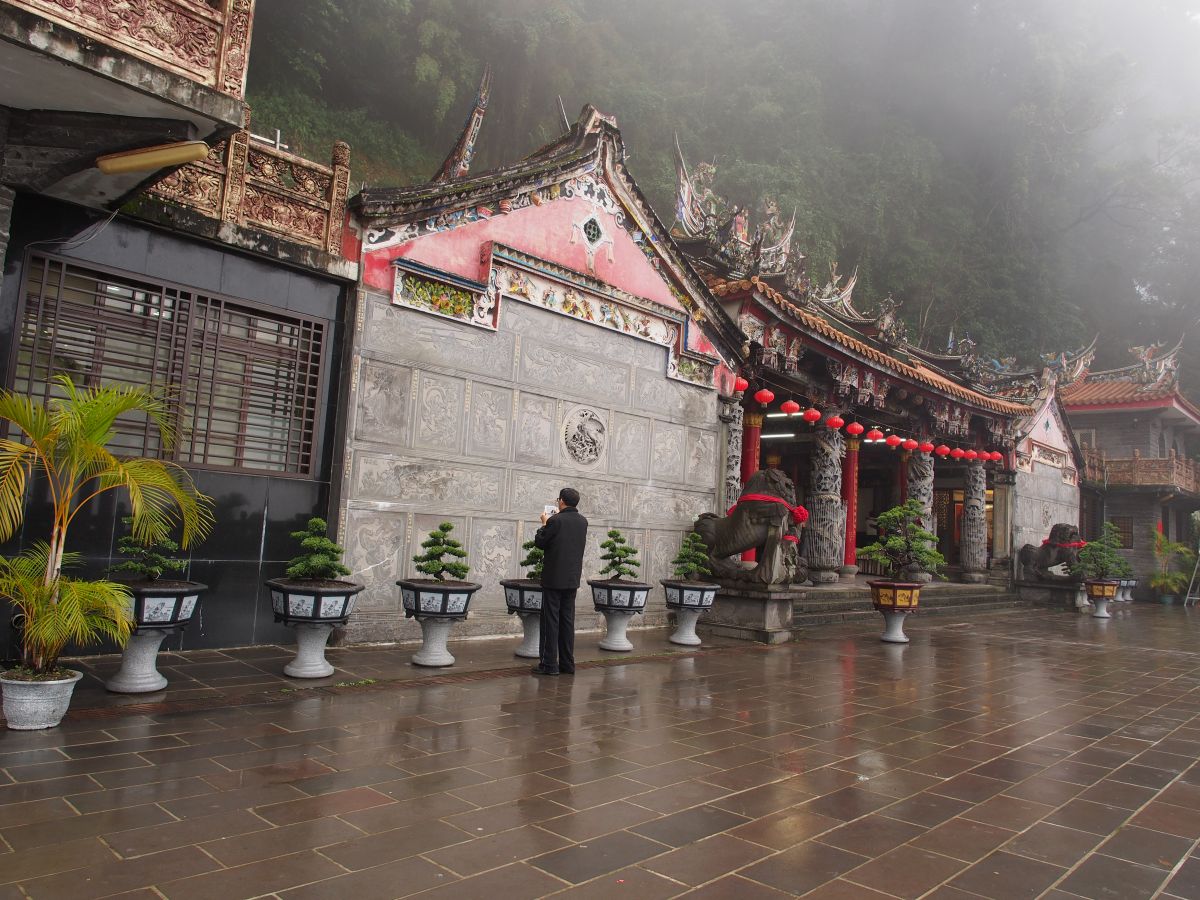 The evening was spent reading and relaxing with occasional little strolls to see what was going on in the temples and to check out some massive firecrackers going off in the valley below. They sounded more like artillery shells than firecrackers. Then it was early to bed. The hotel had a lot more occupants than on my first night and there was a lot of shouting and laughing and the slamming of doors. That is another characteristic of the Taiwanese people that you simply have to accept and get used to. Doors are to be slammed, not closed. And it is your sworn duty to open and then slam the door as many times as possible. I lie there in my room on most occasions like this and try to imagine how many reasons there might be to leave your room and then go back into it. In my regular day, I might leave my room to go out for the day. Then I return at the end of the day. I go out to have dinner and then return to bed down for the night. That’s about it. I could probably come up with two or three other small errands to run which involve me leaving my room. But I can’t begin to come up with enough reasons to cover the dozens and dozens perhaps hundreds of times people here leave their rooms and then return to them, loudly slamming the door each time. There is nothing outside the room but a long and dark hallway. What could be out there that is so important? My secret weapon for these occasions consists of ear plugs. I keep a massive supply on hand at all times. Those and eye shades. Better to deal with the problem than to lie there and be annoyed. Still, without earplugs, I would probably never get any sleep at all.
The evening was spent reading and relaxing with occasional little strolls to see what was going on in the temples and to check out some massive firecrackers going off in the valley below. They sounded more like artillery shells than firecrackers. Then it was early to bed. The hotel had a lot more occupants than on my first night and there was a lot of shouting and laughing and the slamming of doors. That is another characteristic of the Taiwanese people that you simply have to accept and get used to. Doors are to be slammed, not closed. And it is your sworn duty to open and then slam the door as many times as possible. I lie there in my room on most occasions like this and try to imagine how many reasons there might be to leave your room and then go back into it. In my regular day, I might leave my room to go out for the day. Then I return at the end of the day. I go out to have dinner and then return to bed down for the night. That’s about it. I could probably come up with two or three other small errands to run which involve me leaving my room. But I can’t begin to come up with enough reasons to cover the dozens and dozens perhaps hundreds of times people here leave their rooms and then return to them, loudly slamming the door each time. There is nothing outside the room but a long and dark hallway. What could be out there that is so important? My secret weapon for these occasions consists of ear plugs. I keep a massive supply on hand at all times. Those and eye shades. Better to deal with the problem than to lie there and be annoyed. Still, without earplugs, I would probably never get any sleep at all.
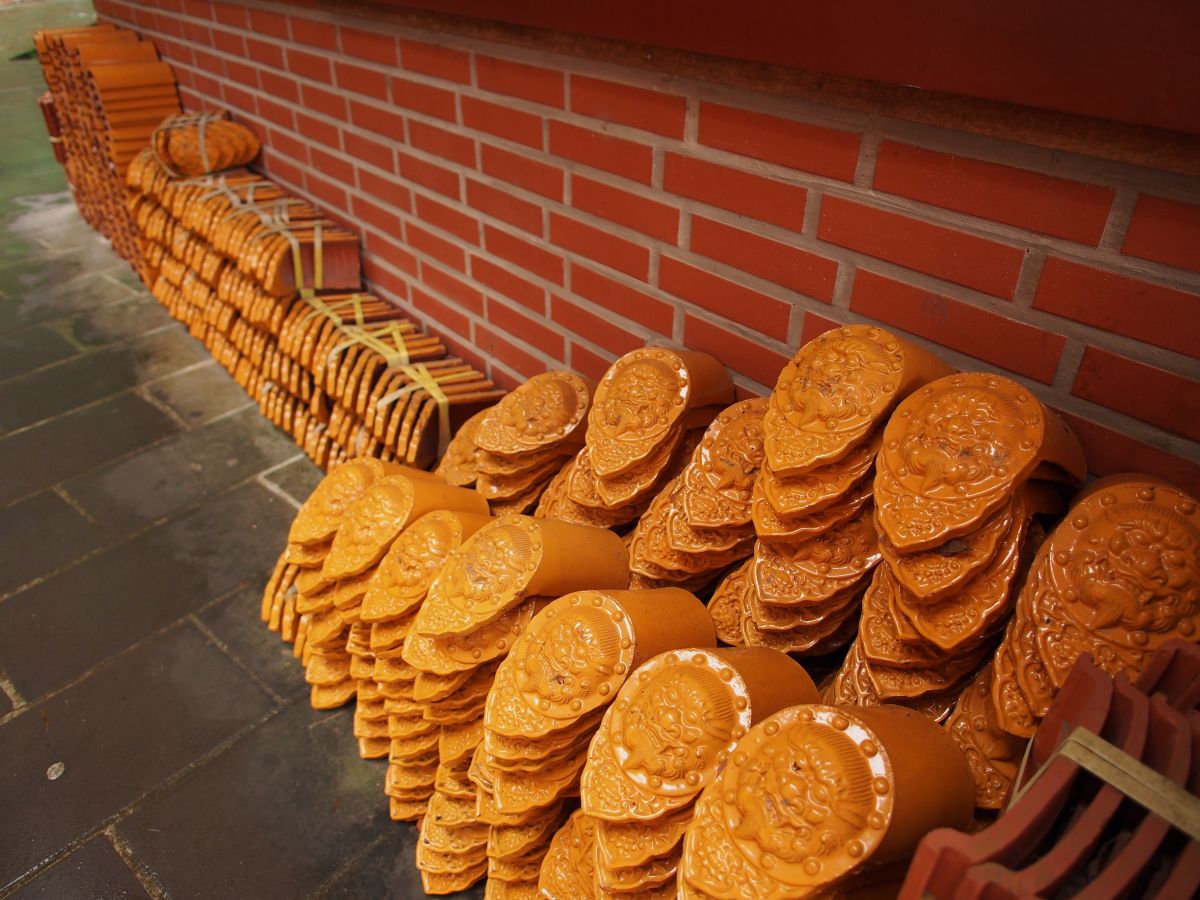 It’s just as misty and cloudy today as it has been every day. It will be interesting to see what the weather is like down off the mountains. My goal for today is to drive to the large city of Taichung. I believe it is the third largest city in Taiwan. It is almost always sunny there, and I shall see if it is sunny today.
It’s just as misty and cloudy today as it has been every day. It will be interesting to see what the weather is like down off the mountains. My goal for today is to drive to the large city of Taichung. I believe it is the third largest city in Taiwan. It is almost always sunny there, and I shall see if it is sunny today.
It’s now 8:30 in the morning. I’ll be on the road by 9:30 or so, and I’ll have the whole day to drive to Taichung and explore the area as I go. I’m a bit sad about leaving the mountains and heading back into urban jungle. But it will be nice to spend some time in a different city.
Time to pack up and get going.
Tags: CNY Scooter Trip Taiwan 2013, Cyuanhua Temple Group, scooter, Taiwan, temple, Visitor Center

